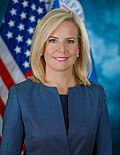First Trump Cabinet | |
|---|---|
| Cabinet of the United States | |
| 2017–2021 | |
 The first cabinet of President Donald Trump in March 2017 | |
| Date formed | January 20, 2017 |
| Date dissolved | January 20, 2021 |
| People and organizations | |
| President | Donald Trump |
| President's history | Chairman of The Trump Organization (1971–2017) |
| Vice President | Mike Pence |
| Member party | Republican Party |
| Status in legislature | Majority government (2017–2019) Divided government (2019–2021) 241 / 435 (55%) 52 / 100 (52%) (2017–2019)200 / 435 (46%) 53 / 100 (53%) (2019–2021) |
| Opposition party | Democratic Party |
| History | |
| Election | 2016 presidential election |
| Legislature terms | 115th Congress 116th Congress 117th Congress (17 days) |
| Budgets | 2017 budget 2018 budget 2019 budget 2020 budget |
| Advice and consent | United States Senate |
| Predecessor | Obama cabinet |
| Successor | Biden cabinet |
Donald Trump assumed office as the 45th president of the United States on January 20, 2017, and his first term ended on January 20, 2021. The president has the authority to nominate members of his cabinet to the United States Senate for confirmation under the Appointments Clause of the United States Constitution.
Contents
- Cabinet
- Cabinet officials on January 20, 2021
- Cabinet-level officials
- Confirmation process
- Analysis
- Confirmation delays
- History
- Formation
- Elected officials
- President
- Vice President
- Nominated candidates for Cabinet positions
- Secretary of State
- Secretary of the Treasury
- Secretary of Defense
- Attorney General
- Secretary of the Interior
- Secretary of Agriculture
- Secretary of Commerce
- Secretary of Labor
- Secretary of Health and Human Services
- Secretary of Housing and Urban Development
- Secretary of Transportation
- Secretary of Energy
- Secretary of Education
- Secretary of Veterans Affairs
- Secretary of Homeland Security
- Nominated candidates for Cabinet-level positions
- White House Chief of Staff
- United States Trade Representative
- Director of National Intelligence
- Ambassador to the United Nations
- Director of the Office of Management and Budget
- Director of the Central Intelligence Agency
- Administrator of the Environmental Protection Agency
- Administrator of the Small Business Administration
- Removal of the Chair of the Council of Economic Advisers
- See also
- Explanatory notes
- Citations
- External links
Before confirmation and during congressional hearings a high-level career member of an executive department heads this pre-confirmed cabinet on an acting basis. The cabinet's creation was part of the transition of power following the 2016 presidential election.
This article documents the nomination and confirmation process for any successful or unsuccessful cabinet nominees of the first Trump administration. They are listed in order of creation of the cabinet position (also used as the basis for the United States presidential line of succession).
































































































































